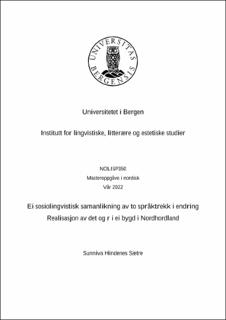| dc.contributor.author | Sætre, Sunniva Hindenes | |
| dc.date.accessioned | 2022-06-07T23:43:12Z | |
| dc.date.available | 2022-06-07T23:43:12Z | |
| dc.date.issued | 2022-05-20 | |
| dc.date.submitted | 2022-06-07T22:00:51Z | |
| dc.identifier.uri | https://hdl.handle.net/11250/2997784 | |
| dc.description | Revised version. Minor spelling and formatting errors corrected. | |
| dc.description.abstract | Denne masteroppgåva er ei undersøking av variasjonen /dɑ:/ og /de:/ og rulle-r og skarre-r. I tradisjonelt strilemål har det i utgangspunktet blitt brukt /dɑ:/ for det, og r-en har blitt uttalt med rulle-r. Desse trekka er no i endring, der /de:/ er på veg inn, og der bruk av rulle-r no berre finst blant dei eldre innbyggarane. Undersøkinga ser på både sosiolingvistiske og indrespråklege faktorar for språkendringane. Dei indrespråklege faktorane blir brukt som beskriving av endringane, og dei sosiale som forklaring på kvifor endringane skjer. Undersøkinga er basert på individuelle intervju med tolv informantar. Desse var fordelte på tre aldersgrupper, med to av kvart kjønn i kvar gruppe. Aldersgruppene var: 15-20, 45-50 og 75-80. Informantane er henta frå Kløvheim skulekrins. Den overordna problemstillinga for prosjektet lyder som følger: Korleis går ei leksikalsk språkendring føre seg, samanlikna med ei fonologisk? For å løyse problemstillinga, har eg svart på følgande spørsmål: 1) Kor raskt skjer endringane? 2) Dannar endringane eit sosialt mønster? 3) Utviklar endringane seg etter eit bestemt, indrespråkleg system? Dei sosiale variablane brukt i prosjektet er alder, kjønn og lokal tilhøyrsle. Lokal tilhøyrsle er ein variabel sett saman av ulike indikatorar. Det blei laga to ulike indeksar for aldersgruppene, der den eine gjaldt aldersgruppa 15-20 år, og den andre aldersgruppene 45-50 år og 75-80 år. Indeksane er basert på teori om nettverk og lokal identitet. Informantane kunne få maksimalt 10 poeng. Resultata viser at overgangen til /de:/ går saktare enn kva overgangen til skarre-r har gjort. Dei viser også ein klar samanheng mellom høg score på lokal tilhøyrsle, og bruk av tradisjonsforma /dɑ:/. Ein finn ikkje tilsvarande samanheng når det gjeld rulle-r, då denne språklege variabelen er eit aldersbasert fenomen. Kvinnene har ein tendens til å bruke /dɑ:/ meir enn mennene, men ein finn ikkje tilsvarande korrelasjon for r-uttalen. Resultata viser tendensar til eit indrespråkleg system for det-variantane. Det eine har med syntask å gjere, det andre med fonologi. Ein finn ikkje eit indrespråkleg system for r-uttalen. Her finn ein heller forskjellige måtar å variere på. På den måten kan ein omtale den indrespråklege overgangen til /de:/ som systematisk, og den indrespråklege overgangen til skarre-r som meir kaotisk. | |
| dc.description.abstract | This master thesis is a study of the variation between /dɑ:/ and /de:/, which are two different ways to pronounce it, and front-r and back-r, which are two different ways to pronounce the Norwegian r. In the traditional dialect strilemålet, /dɑ:/ is the main way of pronouncing it, and front-r the main way of pronouncing the r. These features are now changing. /de:/ is used more and more, and the front-r is now only used by the elderly. The study involves both sociolinguistic and internal factors of language change. The internal factors are used as a description of the language changes, and the social ones as an explanation for why the changes occur. The study is based on interviews with twelve informants. They were divided into three age groups, with two from each gender in each group. The age groups were: 15-20, 45-50 and 75-80. The informants live in Kløvheim skulekrins. The study focuses on the differences between a lexical and a phonological language change. This has been done by answering the following questions: 1) How fast do the changes happen? 2) Do the changes form a social pattern? 3) Do the changes develop according to a specific, internal language system? The social variables used in the project are age, gender and local attachment. Local attachment is a variable composed of different indicators. Two different indexes were created for the age groups, one of which concerned the age group 15-20, and the other age groups 45-50 and 75- 80. The indexes are based on theory about network and local identity. The informants could get a maximum of 10 points. The results show that the transition to /de:/ is slower than the transition to back-r. They also show a clear connection between a high score on local attachment, and the use of the traditional variant /dɑ:/. The results show that there is no such connection between the front-r and local attachment. This linguistic variable is clearly an age-based phenomenon. Women tend to use /dɑ:/ more than men, but we do not find the same correlation for the r- pronunciation. The results also show tendencies towards an internal language system for the pronunciation of it. One has to do with syntax, the other with phonology. There is no internal language system for the r-pronunciation. Therefor we can refer to the internal language transition to /de:/ as systematic, and the internal language transition to back-r as a more chaotic process. | |
| dc.language.iso | nno | |
| dc.publisher | The University of Bergen | |
| dc.rights | Copyright the Author. All rights reserved | |
| dc.title | Ei sosiolingvistisk samanlikning av to språktrekk i endring: Realisasjon av 'det' og 'r' i ei bygd i Nordhordland. | |
| dc.title.alternative | A sociolinguistic comparison of two changing language features: The realization of 'det' (it) and 'r' in a small community in Nordhordland. | |
| dc.type | Master thesis | |
| dc.date.updated | 2022-06-07T22:00:51Z | |
| dc.rights.holder | Copyright the Author. All rights reserved | |
| dc.description.degree | Mastergradsoppgave i nordisk språk og litteratur | |
| dc.description.localcode | NOLISP350 | |
| dc.description.localcode | MAHF-LÆNO | |
| dc.description.localcode | MAHF-NORD | |
| dc.subject.nus | 711123 | |
| fs.subjectcode | NOLISP350 | |
| fs.unitcode | 11-21-0 | |
